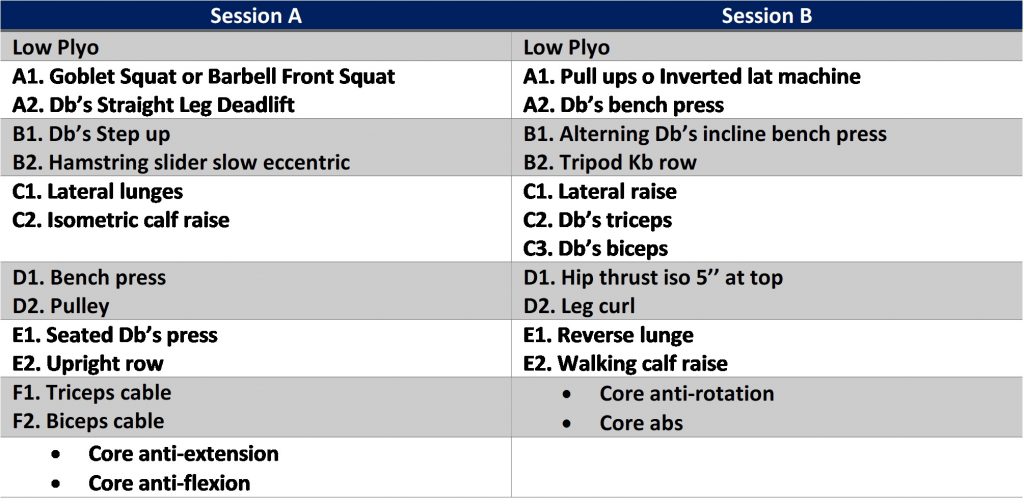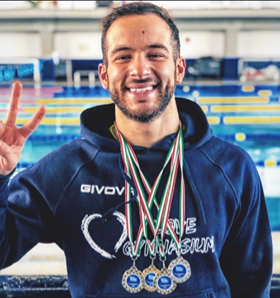INTRODUCTION
For every sport, race, and competition, the season has an end. However, the period between the post-season and the 6 weeks (this time may be varied) before the first competition of the season is called OFF-SEASON. This phase includes most of the preparatory period and can be divided into several short mesocycles, for example, 8 to 12 weeks, in some cases even 2-3 weeks for elite athletes. The duration depends on the individual athlete, particularly age, gender, acquired skills and training experience. For example, younger and less developed athletes may spend a good portion of time in general physical preparation and then move on to a strength or hypertrophy phase if needed. On the other hand, for the athlete with a stronger training background who is offered a full postseason phase, devoting even just 2 or 3 weeks of general physical preparation may be sufficient before moving on to the next microcycle. Although during this phase athletes are free from games and competitions, I definitely want to mention that this does not mean having full-time off and vacations.
…but then what are the goals of this phase?
The purpose of an offseason training program is to prepare the athlete
- to tolerate the intensity of future competition
- reducing the probability of preventable injuries
- Optimizing athletic performance
Warning! Many of you will say that the last 2 points are the ultimate goal of any good training and not just the off-season, that is true! Is there then a specific phase of the year called off season? Theoretically yes, but in practical terms I think not. Whether we are in season with our team or in the postseason or “off-season…to sustain the intensity in a gradual way, reduce where possible the probability of injury and improve the athletic performance of the individual or the team, are the result of good training at any stage of the year in which we are. Nothing else! So, let’s not focus so much on the division of periods or phases, but on the principles of sports physiology that govern training!
In fact, the off-season endurance training plan must address the physiological demands of the sport with the physical strengths and weaknesses of each individual athlete. A well-planned off-season endurance training program will have a profound positive effect on the athlete’s athletic development, unlike a non-planning plan. Where I am, who I am with, and what I am going to do are the questions I need to answer before writing a reasonable training program.
Have clear ideas with 3 simple questions!
Returning to the topic at hand…
The primary goal of the off-season phase is to maximize strength and power, and especially if there is a need to give importance to hypertrophy … especially for young athletes with little muscle mass! Quality of movement, mobility, flexibility, and core strength are also goals to aim for in this phase…but you’ll agree with me that this is always the goal. So I say again: is there such a thing as a real off-season? Think about it! Now I don’t want to get too theoretical and talk a lot, better to share with you a practical example that I used with my basketball team during the off-season.

The program is developed on 3 weekly sessions with ABA BAB schedule, performed on Monday, Wednesday and Friday. Example: Monday A, Wednesday B, Friday A. The following week will be: Monday B, Wednesday A, Friday B. The muscle groups we train in session A are the same as in session B, what changes are the exercises, in this way we offer different stimuli but with the same objective. As you can see the program seems a little long, which is why I thought of working with the superset method.
Example: A1 exercise + A2 exercise + pause. Repeat the sequence for the number of times indicated.
This method in addition to making the workout faster, increases conditioning levels, provides proper muscle balance, offers cleaner neuromuscular and recruitment signal and function, and increases blood flow to body segments. The duration of this program is 4 weeks: week 1 with low load, week 2 with medium load, week 3 with high load and week 4 with low load. Regarding the number of reps, it is recommended to go down from 20-12 reps to 6-10 reps as the weeks progress, with a buffer being 1 rep before exhaustion or at exhaustion.
Example: week 1 4×15, week 2 4×12, week 3 4×10-8, week 4 3×6-8
Each exercise can have a minimum of 2 to a maximum of 4 sets.
Example: Session A= A1 4×12 + A2 4×12, B1 3×10 + B2 3×10, F1 2×15-20 + F2 2×15-20.
Regarding the percentage of load used we recommend intensities between 60-80% 1RM. The recovery time at the end of each superset is 60’’-120”, while the recommended mode of execution is a slow eccentric, a possible break between eccentric and concentric and a fast concentric.
This progression of SeriesXRepetitions and the mode of execution allow us to prepare the body for the next phase: strength or hypertrophy (if necessary) are the recommended choices.
To conclude…
Increasing performance potential in the off-season has many benefits and is the foundation of personal athletic growth. All in all, off-season training is important regardless of the sport because it is a time not only to rest, but also to develop, improve, and focus on skills that directly and indirectly affect competitive performance.
References
- Bompa,T. Periodization:Theory and Methodology of Training.4th rd.Champaign,IL: Human Kinetics,1999.
- Stone, MH, Stone, M, and Sands, W.Principles and Practice of Resistance Training. Champaign, IL; Human Kinetics, 2007.
- Williams, TD, Tolusso, DV, Fedewa, MV, and Esco, MR. Comparison of periodizen and non periodizen resistance training on maximal strength: A meta-analysis. Sport Med 47:2083-2100, 2017.
- Zatsiorsky, V, and Kraemer, W.Science and Practice of Strength Training. 2nd ed. Champaign, IL; Human Kinetics, 2006.
ALBERTO ZURLO

CHECKOUT ALBERTO’S CONTENT HERE:
Instagram: https://instagram.com/albertozurlo_coach
